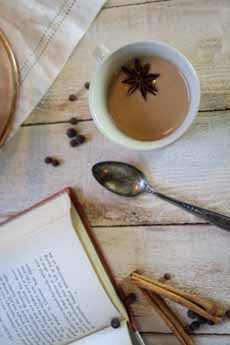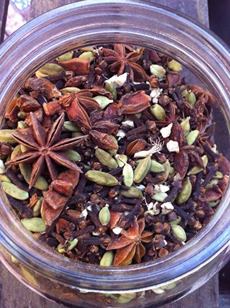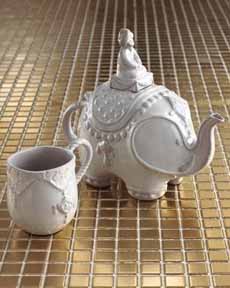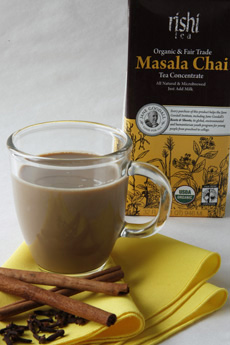TIP OF THE DAY: Make Masala Chai Concentrate
 [1] A cup of chai, garnished with star anise. You can re-use one of the stars used to brew the concentrate (photo courtesy The Prairie Homestead).
|
The fall season ushers in traditional autumnal foods and beverages. In the latter department, there are apple cider, hot chocolate, mulled wine/mulled cider/hot buttered rum, spiced tea (like Constant Comment), flavor twists on cocktails (like a maple Old Fashioned), and the infamous Pumpkin Spice Latte (infamous for its 50g of sugar). And then, there’s masala chai, which translates to “spiced tea” in English: masala means “spice blend” or “mixture of spices” in Hindi/Urdu‡, and chai is the word for tea. Note that when someone asks for “chai tea,” in English, they’re asking for “tea tea,” since “chai” already means tea! This is called redundant translation, and if you enjoy learning the quirks of language, check out the ‡‡footnote. The full term “masala chai” specifically refers to tea brewed with a blend of aromatic spices like cardamom, cinnamon, cloves, ginger, and black pepper, along with milk and sugar. While everything else on the fall beverage list has been on American menus for centuries, chai has only become nationally popular since the end of the 19th century, when artisan tea companies began to add it to their line. See the history of chai below. The recipe that follows, from Jill Winger of The Prairie Homestead is, pleasantly sweet and spicy, but not too sweet or too spicy. After you try the first batch, you can make it sweeter and/or spicier. Use your sweetener of choice, or none at all so that people (dieters, the sugar-averse) can have their drink as they prefer. The recipe follows, but first, tea lovers can mark this whole list of tea holidays: > The history of masala chai is below. > The different types of tea: a photo glossary. Ingredients For 1 Quart Of Concentrate 1. BRING the water and sweetener to a boil in a medium pot, and simmer until the sweetener is fully dissolved. 2. ADD all of the spices, and continue to simmer on low heat for 20 minutes. 3. REMOVE the mixture from the heat, add the tea bags, and let them steep for 10 minutes. 4. STRAIN out the spices and tea bags and store the concentrate in the fridge (it will last for several weeks). 5. SERVE: Mix the chai concentrate 1:1 with milk. Gently heat in a small saucepan until it reaches the desired temperature (we heated it for 2:45 minutes in our microwave; yours may take less or more time). Pour into a mug and enjoy…perhaps with some graham crackers. |
|
|
THE HISTORY OF CHAI (MASALA CHAI) The original masala chai (masala means spice, chai means tea), is very different from the contemporary recipe. The first version was an ancient Indian ayurvedic beverage—a cleansing spice tonic that did not include any tea. When the British began to establish tea plantations in Assam, in 1835, they added milk and sweetener to their tea, as they did at home. At the time, tea was too expensive for most Indians and was largely grown for export (this is unfortunately true of other third-world crops, including coffee). In the early 1900s, the British-owned Indian Tea Association began to promote tea consumption to Indian consumers. Because black tea was still an expensive ingredient, vendors used milk, sugar and spices—the ingredients of today’s masala chai—to create a flavorful drink while keeping costs down. The drink’s popularity spread throughout India and became even more popular in the 1960s, when mechanized tea production made black tea affordable for the common man. *CHAI VS. TEA: All related forms of the word chai—Turkish çay, Russian/Persian/Hindi/Urdu chay, etc.—derive from the original Mandarin, cha. Cha became the Cantonese, Mandarin and Japanese word for tea. Other Chinese dialects have different words; e.g. the Wu dialect spoken around Shanghai uses the word zu and the Hokkien dialect spoken around the port of Xiamen in the Fujian province uses the word tay. The word “cha” traveled to the Middle East and Eastern countries, while “tay” traveled to Europe and became our word for tea. Xiamen was the port of trade first used by Europeans (mainly the Portuguese) in 1541. Near the end of the Ming Dynasty, in 1644, British merchants set up trading posts there; in the 19th century, it was China’s main port for exporting tea. As a result, the Hokkien dialect spoken there, not Mandarin which traveled west via overland trade routes, influenced what Europeans called the beverage. What the Xiamenese people call tay, the British spell tea, the French spell thé, the Spanish té, the Italians tè and the Germans, tee. The pronunciation varies from “tay” to “tee.” Other words from the Hokkien language that entered English: ketchup (kiô-chap), Pekoe (pekh-hô), kowtow (khàu-thâu) and Japan (Jit-pún). †Cream tea is a refreshment of a baked scone with jam and clotted cream, served with a cup of tea. It is traditionally enjoyed in the afternoon, often after lunch; but is much simpler than the more elaborate afternoon tea. It originated in the southwest of England in Devon and Cornwall, but now can be found all around the U.K. ‡Hindi and Urdu are very closely related languages that share the same grammatical structure and much of their vocabulary, but they differ in several key ways. Briefly, Hindi is the official language of India (along with English). Urdu is more associated with Islamic culture and was historically the court language of Muslim rulers in the Indian subcontinent. Urdu is the national language of Pakistan and also spoken by Muslims in India. In everyday conversation, Hindi and Urdu speakers can easily understand each other: The spoken forms are essentially the same language. In writing, however, Hindi uses the Devanagari script (the same used for Sanskrit) while Urdu uses a modified Arabic script, written right to left. Linguistically, many scholars consider them to be two standardized forms of the same language, sometimes called Hindustani. Food Terms: Geographic Terms: Other Examples: Most English speakers use redundant terms unconsciously and without any intent to be redundant: They’ve simply learned the phrases that way. However, in academic or professional contexts precision matters. Even in social situations, should you correct someone? Yes, if you perceive that the person would welcome the knowledge. CHECK OUT WHAT’S HAPPENING ON OUR HOME PAGE, THENIBBLE.COM.
|
||





